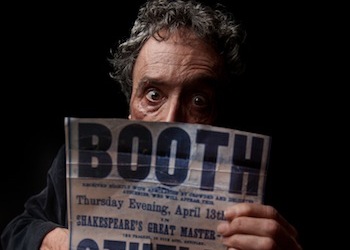An Unsteady John Wilkes Booth
BANG! The Curse of John Wilkes Booth
New York International Fringe Festival
Gene Frankel Theater
24 Bond Street
New York, N.Y.

Writer/actor Scott Baker had a decent idea for his play Bang! The Curse of John Wilkes Booth. Baker, who stars in the one-man play, assumed, as some have claimed, that Booth was not killed by federal troops in a barn on the Garrett farm near Port Royal, Virginia, after Booth assassinated President Abraham Lincoln at Ford’s Theater on April 14, 1865. In his play, he insists that, somehow, Booth survived the troopers that trapped him, and the fire that destroyed the barn, escaped and lived for decades in the Midwest. Baker’s one-man play is about the lives of some of the men who in later years insisted they were really Booth.
There are several segments to the play. In the first, Baker plays Booth and tells the assassin’s tale. In the next few, he assumes the character of the Booth impersonators and explains their story. From time to time, he becomes the narrator of each story.
On paper, this is a reasonably good concept. There were several people in the 1870s and 1880s who claimed they were Booth, such as John St. Helen, who moved to Granbury, Texas and lived until 1903. There are two problems, though. First, historically, the troops did kill John Wilkes Booth. There was an autopsy by two Army doctors. A half-dozen people who knew Booth identified his remains. Four years later, his mother and other relatives also identified his remains. Second, actor Baker’s howling, ranting and raving as he depicts his characters destroyed whatever chance there was to carry off this concept.
Baker makes an absolute mess out of the play, the dark Booth legacy, the Lincoln shooting and American history in general.
The play starts off badly with Baker sitting in a chair as Booth, starting to tell his story. He begins yelling right away and then gets up and cavorts about the small, dark stage, filled with a chair, a trunk and, a table with bottles of liquor on it (presumably filled with water, but with a play like this, one wonders) that he drinks incessantly for the eighty minutes of this tedious show. He plays Booth as a deranged madman and you have to ask yourself how anybody this unbalanced put together a plot to murder the president.
Abut twenty minutes later, Baker starts his wacky depictions of the Booth impersonators. The stories are pretty interesting, but, of course, they don’t hold up. In one case, Baker insists that a man is Booth simply because he and Booth were the same age at their death. The most exotic story was that of the mummy of John Wilkes Booth, or John St. Helen, that was shown for years at a carnival sideshows across the U.S.
You find it hard to listen to any of the stories, though, because Baker wails away, flapping his arms, nodding his head and shouting at the top of his lungs.
John Wilkes Booth, the assassin, was an intriguing, evil character, one of the great villains in American history, but you don’t learn much about him in this mess of a show.
PRODUCTION: Produced by the New York International Fringe Festival and The Drilling CompaNY. The play is directed by Richard Harden.
